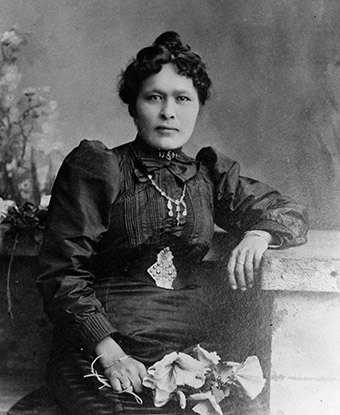Last updated: July 28, 2020
Person
Shaaw Tláa (Kate Carmack)

Yukon Archives, James Albert Johnson fonds, 82/341, 21 #.
Early Life
The first woman of the Klondike was Shaaw Tláa, also known as Kate Carmack. Shaaw Tláa spent her childhood in south-central Yukon. Native Tagish, Shaaw Tláa was one of eight children born into an arranged marriage between the coastal Tlingit people and the Tagish to formalize trading partnerships. Shaaw Tláa’s first husband, a Tlingit man, and their infant daughter died during an influenza epidemic plagued by the Alaska Native population of Alaska and the Yukon. Her mother encouraged her to marry her deceased sister’s husband, a white man named George Carmack. In January 1893, seven years after their marriage, Kate gave birth to their daughter, Graphie.
The Gold Rush Begins
In 1896 Shaaw Tláa was traveling in remote Canada with her husband George, her brother Keish (Skookum Jim), and Ka'a Goox (Dawson Charlie). On August 17, 1896, the group discovered a significant amount of gold as they stopped to fish along Rabbit Creek, a small tributary of the Klondike River. While debate remains about who first made the discovery of the first claim, it was staked by George Carmack, the only white member of the group.
News of this gold quickly spread and ignited the Klondike Gold Rush of 1897-98. Like other early Klondike women, Shaaw Tláa did very well in the beginning. For the first year after the big discovery of gold, little changed in Shaaw Tláa’s life. She and George worked their rich mining claim for two seasons. In their cabin, Shaaw Tláa kept house, cared for their daughter and took in laundry. She sewed moccasins and warm winter clothing to sell to other miners and helped provide meals for her family by picking berries and trapping rabbits and ptarmigan.
Post Gold Rush
In the fall of 1898, the family decided to go to Seattle to celebrate their riches. They planned to buy a yacht to sail to Paris with their millions. Adapting to life in the big city was not easy for Shaaw Tláa and within a year, George and Shaaw Tláa's marriage fell apart. After 13 years of marriage, he left her for another woman and claimed that they had never been officially married. Shaaw Tláa attempted to file for divorce, but there was no official record of their marriage. George remarried another woman by late 1900.
Upon her return to the Yukon Territory, Keish built Shaaw Tláa a cabin in Carcross, where most of their family had settled. Shaaw Tláa earned a small income from selling needlework to tourists. Once her daughter Graphie was 16, George lured her to Seattle. It was a devastating loss, as Shaaw Tláa held firmly to the Tagish belief that children belong with the mother’s clan. Graphie married and never saw her mother again.
Shaaw Tláa remained with her Tagish clan and lived out the rest of her life in Carcross, Yukon Territory. She never received her share of any mining riches and was supported by a government pension until her death. She died during an influenza epidemic on March 29, 1920 and was buried in the Carcross cemetery at the age of 63.
